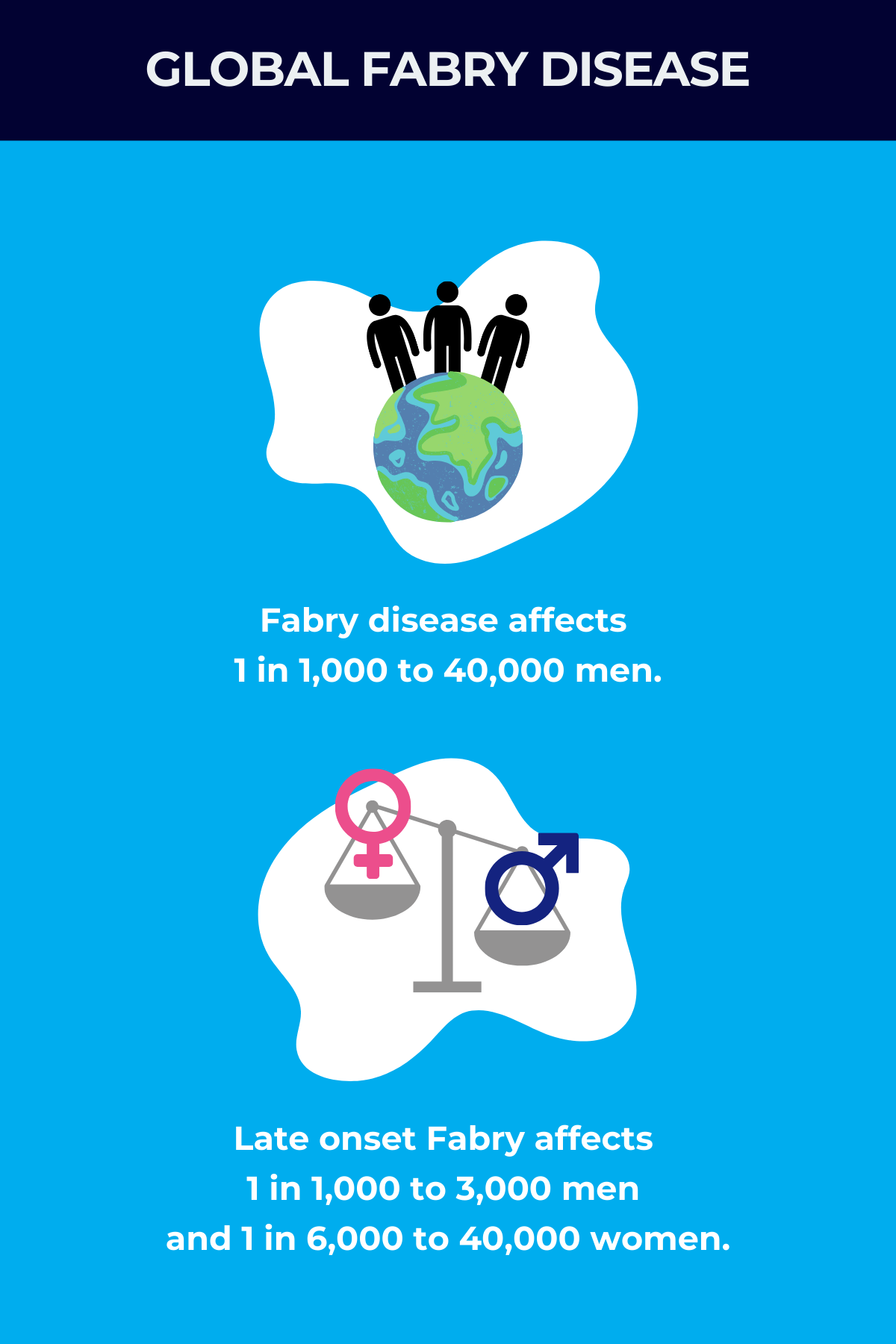Fabry disease prevalence
Last updated May 31, 2024, by Susie Strachan

Fabry disease is a rare genetic disorder that affects 1 in 1,000 to 1 in 40,000 boys and men worldwide, depending on the form of the disease.
Caused by mutations in the GLA gene, Fabry can lead to symptoms such as pain, a decreased ability to sweat, cloudiness of the cornea in the eye, problems with the gastrointestinal system, and hearing loss.
Women can also develop the disease and experience a diverse range of clinical symptoms, some similar in severity level to those experienced by men with Fabry, according to recent studies.
How common is Fabry disease?
Fabry disease prevalence estimates vary widely, depending on the type of the disease. There are two recognized types: the classic form that typically appears in childhood or adolescence, and a late-onset form where people start having Fabry disease symptoms after age 30. Fabry can affect all racial and ethnic groups.
Due to a mutation in the GLA gene that normally provides instructions for making an enzyme called alpha-galactosidase A, people with Fabry are unable to clear a specific type of fat called globotriaosylceramide from their body’s cells. The alpha-galactosidase A enzyme breaks down and helps eliminate this fatty substance.
The type of Fabry is also linked to a person’s enzyme activity levels, with the late-onset form having higher levels of alpha-galactosidase A activity.
The late-onset form is more common, affecting about 1 in 1,000 to 3,000 men and 1 in 6,000 to 40,000 women.
The classic type is rarer and is estimated to affect approximately 1 in 22,000 to 40,000 men.
However, due to underdiagnosis, the actual number of people living with Fabry disease may be higher than reported.

Impact of genetics on prevalence
Fabry disease is inherited in an X-linked pattern, making it more likely to be diagnosed and reported in men.
Men have one X chromosome and one Y chromosome, while women have two X chromosomes.
The GLA gene is located on the X chromosome. If a man inherits the mutated GLA gene from his mother, he will develop Fabry disease because he has only one X chromosome, and it carries the defective gene.
Women have two copies of the GLA gene, one on each X chromosome. The healthy copy can, in some cases, compensate for the mutated/defective copy they receive from one of their parents. This can lead to an underreporting of the true prevalence of Fabry among women.
However, different from other X-linked disorders, Fabry disease can cause significant signs and symptoms in women with one mutated copy of the GLA gene. Symptoms in women tend to begin later in life, compared with men.
A man with Fabry disease will pass their X chromosome with the mutated GLA gene to all his daughters. In contrast, a woman with a mutated GLA gene has a 50% chance of passing the affected X chromosome to any of their children.
Other factors that affect prevalence
While Fabry disease can affect people of any ethnicity or race, the statistics on how many people have Fabry disease can vary widely based on factors such as geographic location, access to healthcare, and diagnostic practices.
For example, many of the symptoms, such as abdominal pain, nausea, diarrhea, and fatigue, are common in other conditions. Furthermore, symptoms are usually mild in the early stages of the disease, and, in most cases, develop only as a person gets older (late-onset form). Therefore, diagnosis can be delayed, affecting the data on the prevalence of Fabry.
Doctors may not consider Fabry when testing for a cause, so it is not uncommon to be misdiagnosed or to take years to get a diagnosis of Fabry.
Access to healthcare services, including genetic testing, can also affect reporting, particularly in underserved or marginalized populations.
Newborn genetic screening can improve the accuracy of knowing how many people have the disease. Early diagnosis in children not only makes it more likely that treatment can be started sooner, but it also helps in reporting the occurrence of the disease.
Fabry Disease News is strictly a news and information website about the disease. It does not provide medical advice, diagnosis, or treatment. This content is not intended to be a substitute for professional medical advice, diagnosis, or treatment. Always seek the advice of your physician or other qualified health provider with any questions you may have regarding a medical condition. Never disregard professional medical advice or delay in seeking it because of something you have read on this website.
Recent Posts
- Fabry disease may raise risk of renal cell carcinoma: Study
- Myeloid bodies may aid in Fabry diagnosis, treatment monitoring
- Life must go on, even when Fabry disease symptoms flare up
- Fabry disease treatment ST-920 improves kidney function: Data
- Unexpected health events are part of my life with Fabry disease
- Blood biomarkers may reflect disease activity, kidney function
- Real-world study shows burden of heart, other complications in Fabry
- Study identifies eye changes in Fabry that could affect vision
- 5 tips for helping teens with Fabry disease to thrive
- Death of bone tissue a rare, painful Fabry complication: Case report
Related articles






